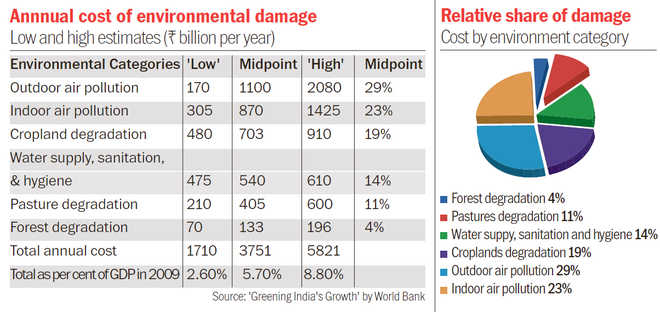
Ajay Sagar
A great deal of discussion has happened on India's gross domestic product (GDP) growth. Also in debate has been the changes carried out by the Central Statistical Organisation in the GDP computational methodology. While this discussion is important, India needs to take a leadership role in projecting its quality GDP growth and not just a quantum GDP growth. A quality GDP growth takes into account growth after adjusting for economic impacts from environment, health and natural resources. Any GDP growth at the cost of environment, pollution, sustainability, health and conservation of natural resources would be more of a liability to our future generations. The discussion here is centred around 'Q' GDP (quality GDP).
Since GDP growth concerns a common man, especially a taxpayer, ‘Q’ GDP growth would make us realise its importance and relevance to stakeholders. No discussion worth its while has taken place on 'Q' GDP and efforts being made by government and other stakeholders in measuring it.
Greening India's growth
A World Bank study titled 'Greening India's Growth' conducted on India's Q GDP growth put the total cost of environmental degradation in India at about 5.7% of GDP in 2009 with outdoor air pollution (29%) and indoor air pollution (23%) accounting for the highest share followed by Cropland degradation (19%), water supply, sanitation and hygiene (14%) amongst others. This number of 5.7% of 2009 GDP as cost of environmental degradation is only a 'midpoint' estimate with 'high' estimate number calculated as 8.8% of GDP. India's GDP growth in 2009 was around 8.59%. If one was to adjust the midpoint cost of environment degradation of 5.7% of GDP, the resultant GDP growth in 2009 was 2.81%. This adjustment using high estimate of 8.8% of GDP would result in negative growth of 0.21%.
Imagine how the 'Q'GDP growth look would like once initiatives to tackle these adverse situations pertaining to environment, health, pollution, natural resources and sanitation are captured. The initiatives include, but are not limited to, Swachch Bharat, replacement of polluting firewood, coal and kerosene chullahas with gas burners, introduction of metro rails, freight corridors and trains, replacement of polluting vehicles, neem coating of urea, ban on stubble burning, cleaning and protection of rivers, making cities smarter, going digital in banking and commerce, reduction in idle time for truck transportation resulting from GST, irrigation and soil strengthening and many more.
Mere provisioning of toilets and improved sanitation will reduce massive costs on account of healthcare; introduction of one train results in taking off of hundreds of transport and passenger vehicles from the road; going digital in banking results in a substantial footfall reduction for bank visits, apart from achieving productivity gains; going organic has a direct positive impact on the number of cancer patients; stubble burning in itself may be a significant cause of India's outdoor and indoor air pollution and thus contributing negatively to India's 'Q' GDP.
GDP down from environment
While a one per cent to two per cent possible temporary reduction in GDP caused by twin positive initiatives of demonetisation and GST has been captured in India's political and economic debate, somehow the substantial 5.7% plus GDP degradation from environment, health and natural resources may just have been overlooked and not even reported. We have a shared responsibility and any discussion on GDP growth without bringing in quality parameters is of very little use.
As a background, GST implementation was achieved through a unanimous legislative vote representing will of the people. Critics of demonetisation have generally raised the issue of cost numbers and the pain associated, but they have remained silent on the hidden advantages of increased tax collection, national security, reduction of cash in circulation, growth in inclusive banking, growth in digital payments and many others.
India has taken a leadership role in assessing quality aspects of its GDP growth by employing computable general equilibrium (CGE) techniques, institutions such as Niti Aayog have an important role in championing India's bold initiatives and achievements to project India in a positive light. While a quantity GDP growth number may look superficially sound, a quality-based GDP growth number will be more in line with Indian culture and civilisation and bring in pride to the citizen. The common man needs to know the 'Q' GDP number that is more relevant in this day and age than a quantity GDP growth number. The quality of debate on India's GDP growth has to move beyond its current state.
The writer has worked with Asian Development Bank



























